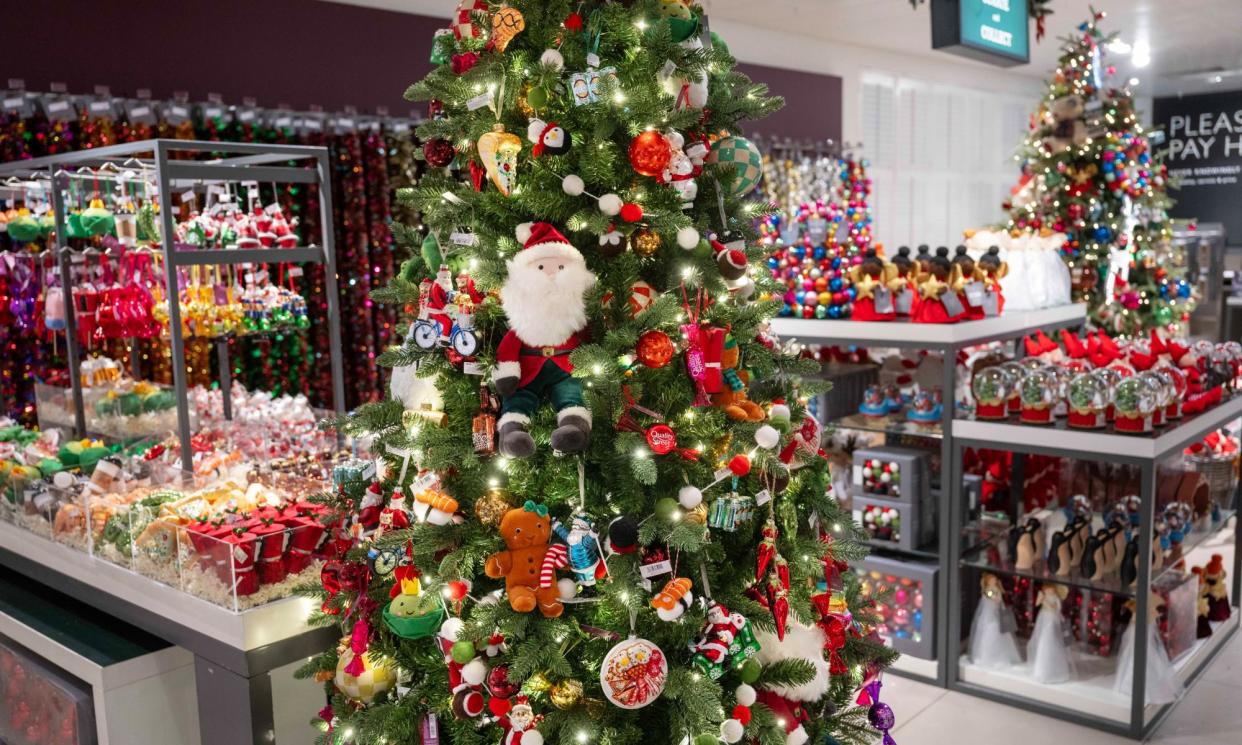Losing its sparkle? The Christmas glitter backlash

The cute tin elephant and ruby teardrop bauble will appeal to magpies sizing up the latest Christmas decor trends, but if your go-to festive look is bling then you may notice something is missing: glitter.
That is the point, of course. The decorations belong to the first “glitter-free” theme in the John Lewis Christmas shop. The department store is latching on to a trend that was turbocharged last year when the EU banned loose glitter as part of a microplastics crackdown that looked poised to end the bloc’s trade in sparkly baubles.
While the law does not apply in the UK because of Brexit, it once again focused attention on the use of the reflective dust that campaigners argue is an environmental scourge.
There is still a blinding shimmer from the tinsel and artificial trees – and decorations with glitter on – in the Christmas grotto of the John Lewis Oxford Street store. But the department store chain’s Christmas buyer, Charlie Murray, says it has “significantly reduced” its presence this year, particularly on decorations.
Instead, John Lewis has tried to create the festive mood using materials such as felt and papier-mache, which have “unique textures that naturally embody the festive spirit”.
“This year on boxed baubles we’re moving towards using glitter that’s encapsulated inside the bauble to prevent shedding,” adds Murray. “We’ve also introduced baubles that have a metallic finish to provide the Christmas sparkle without glitter.”
While some people recoil at the mention of Christmas this far away from the big day, for fans of the festive season the hunt for new tree trinkets is already on. Buying or giving decorations is a relatively new tradition, with the most sought-after – such as Marks & Spencer’s Colin the Caterpillar decoration, selling out straight away. After another difficult year people are clearly in the mood, with sales in John Lewis’s Christmas shop sales running 26% up on last year.
While ornaments encased in red and green glitter once screamed Christmas, these days consumers are showing more interest in less traditional looks, according to John Lewis, with a felt deer dressed in a jacket and scarf one of their current bestsellers. This trend, Murray says, has “naturally allowed us to reduce glitter usage without compromising on our designs”.
Standard glitter is made from etched aluminium bonded to polyethylene terephthalate and the sustainability charity Wrap has long had it on its avoid list. While it brings colour and sparkle to Christmas cards and wrapping paper it warns that its presence is the “kiss of death from a recycling perspective”.
For those who go down the DIY route at Christmas there are sustainable craft options. Hobbycraft, for example, only sells biodegradable glitter. “We know our customers want to add sparkle to their handmade creations, and we ensure our customers have more sustainable materials to choose from,” says Heather Robbins, its trading director.
Whether the objections are environmental or aesthetic, glitter is a “Marmite” product, says Stephen Cotton, a chemical engineer who helped create the eco-friendly alternative Bioglitter in which the plastic is replaced with cellulose. “Some people love it, some people hate it. It is a really emotional product,” he adds.
“Glitter is just a word that just perceives an effect,” he says. “Its use has been vilified in most industries because of the perception that it is bad, when actually it’s all about what glitter is made from. There are now good options available.”
It was not until the EU law was passed that specialist Christmas firms discovered it applied to them. The Belgian decorations maker Goodwill M&G mounted a successful challenge, complaining there had been no consultation and no transition period. In a big climbdown it has been told the law does not apply to Christmas decorations.
“We found out that there were very little alternative … or biodegradable options,” Johan Van Maercke, the chief executive of Goodwill M&G, told the Guardian. Most glitters and decorations are made in east Asia so must withstand extremes of temperature in production and transit, but this had not been considered by lawmakers. “We want consumers to be able to use their decorations for multiple years, without degradation of the glitters applied to the products,” he says.
Whatever the ultimate effect of the EU legislation, Cotton says the move to using non-microplastic glitter is “very complex” and “wholesale change still needs to happen” as it is not being policed in the bloc. “We can still have the bright, fun, sparkly effects that Bioglitter would give, guilt-free. It just needs a little effort in changing.”


